- Understanding the Importance of Fertilisation for Strawberries
- Why is Fertilisation Important?
- Key Nutrients for Strawberries
- When to Fertilise
- Fertilisation Techniques
- Conclusion
- Types of Fertilisers for Strawberries
- The Best Soil Conditions for Strawberries
- 1. Well-Drained Soil
- 2. pH Level
- 3. Organic Matter
- 4. Mulching
- 5. Fertile Soil
- 6. Soil Structure
- When and How to Apply Fertilisers to Strawberries
- Timing of Fertiliser Application
- Methods of Fertiliser Application
- Choosing the Right Fertiliser
- Conclusion
- Common Mistakes to Avoid When Fertilising Strawberries
- Organic vs. Chemical Fertilisers for Strawberries
- Introduction
- Organic Fertilisers
- Chemical Fertilisers
- Choosing the Right Fertiliser
- Conclusion
- Troubleshooting Common Fertilisation Issues with Strawberries
- 1. Over-fertilisation
- 2. Under-fertilisation
- 3. Imbalance of Nutrients
- 4. Inadequate Nutrient Availability
- 5. Environmental Factors
- Tips for Maximising Strawberry Growth and Yield with Fertilisers
- 1. Soil Testing
- 2. Balanced Fertiliser
- 3. Organic Fertilisers
- 4. Controlled-Release Fertilisers
- 5. Foliar Feeding
- 6. Timing and Frequency
- 7. Watering Practices
- 8. Mulching
- 9. Avoid Excessive Fertilisation
- 10. Monitor Plant Health
- Conclusion
- Question-answer:
- What nutrients do strawberries need for proper fertilisation?
- How often should strawberries be fertilised?
- Can organic fertilisers be used for strawberries?
- Is it necessary to fertilise strawberries if they are grown in nutrient-rich soil?
- What are the signs of nutrient deficiency in strawberry plants?
- Can over-fertilisation harm strawberry plants?
- Are there any natural alternatives to chemical fertilisers for strawberries?
- Video: How To Grow The Sweetest Strawberries Ever
Strawberries are a beloved fruit, known for their vibrant red color, sweet taste, and versatility in a wide range of culinary applications. Whether you are a home gardener looking to grow strawberries in your backyard or a commercial farmer aiming to optimize your strawberry yield, understanding the fertilisation needs of this fruit is key to achieving healthy and bountiful plants.
When it comes to fertilising strawberries, there are several important factors to consider. First and foremost is the nutrient composition of the soil. Strawberries require a balance of essential nutrients, including nitrogen, phosphorus, and potassium, to thrive. Nitrogen promotes leaf and stem growth, phosphorus enhances root development and fruit production, while potassium aids in overall plant health and disease resistance.
In addition to these primary nutrients, strawberries also benefit from secondary nutrients such as calcium and magnesium, as well as trace elements like iron, zinc, and manganese. These micronutrients play crucial roles in plant metabolism and are necessary for optimal growth and fruiting. A deficiency in any of these nutrients can lead to stunted growth, poor fruit quality, and increased susceptibility to pests and diseases.
Understanding the Importance of Fertilisation for Strawberries
Growing healthy and productive strawberry plants requires proper fertilisation. Fertilisation plays a vital role in ensuring the plants receive the necessary nutrients they need to thrive and produce high-quality berries.
Why is Fertilisation Important?
Fertilisation is crucial for strawberries because it helps replenish the soil’s nutrient levels. Strawberries are heavy feeders and require a consistent supply of nutrients to grow and develop properly. Without adequate fertilisation, the plants may become weak, produce fewer berries, or become more susceptible to disease and pests.
Key Nutrients for Strawberries
There are several essential nutrients that strawberries require for optimal growth:
- Nitrogen: Nitrogen promotes leaf and stem growth, resulting in healthier plants and larger fruit.
- Phosphorus: Phosphorus aids in root development, flowering, and fruit production.
- Potassium: Potassium improves overall plant vigor and resistance to diseases and pests.
- Calcium: Calcium helps prevent common strawberry disorders, such as blossom-end rot.
When to Fertilise
Strawberry plants have specific fertilisation needs throughout their growing season:
- Pre-Planting: Before planting strawberries, apply a slow-release fertiliser to prepare the soil and provide essential nutrients.
- During Planting: Incorporate a balanced fertiliser into the planting hole to provide a nutrient boost to the young plants.
- Early Growth Stage: Apply a nitrogen-rich fertiliser when the plants start to develop leaves and stems.
- Flowering and Fruiting Stage: Switch to a fertiliser with higher phosphorus content to support flower and fruit formation.
- Repeat Applications: Depending on the specific needs of your soil and plants, repeat fertilisation every 4-6 weeks during the growing season.
Fertilisation Techniques
There are various fertilisation techniques you can use to ensure the optimal nutrient uptake by your strawberry plants:
- Broadcast Spreading: Sprinkle the fertiliser evenly over the soil surface around the plants.
- Side-Dressing: Apply the fertiliser in a narrow band alongside the rows of plants.
- Foliar Feeding: Use a liquid fertiliser spray to directly apply nutrients to the leaves.
- Drip Irrigation: Incorporate a water-soluble fertiliser into the irrigation system for precise nutrient delivery.
Conclusion
Understanding the importance of fertilisation for strawberries is essential for successful and bountiful harvests. By providing the right nutrients at the right times, you can ensure your strawberry plants remain healthy, productive, and capable of producing delicious berries for years to come.
Types of Fertilisers for Strawberries
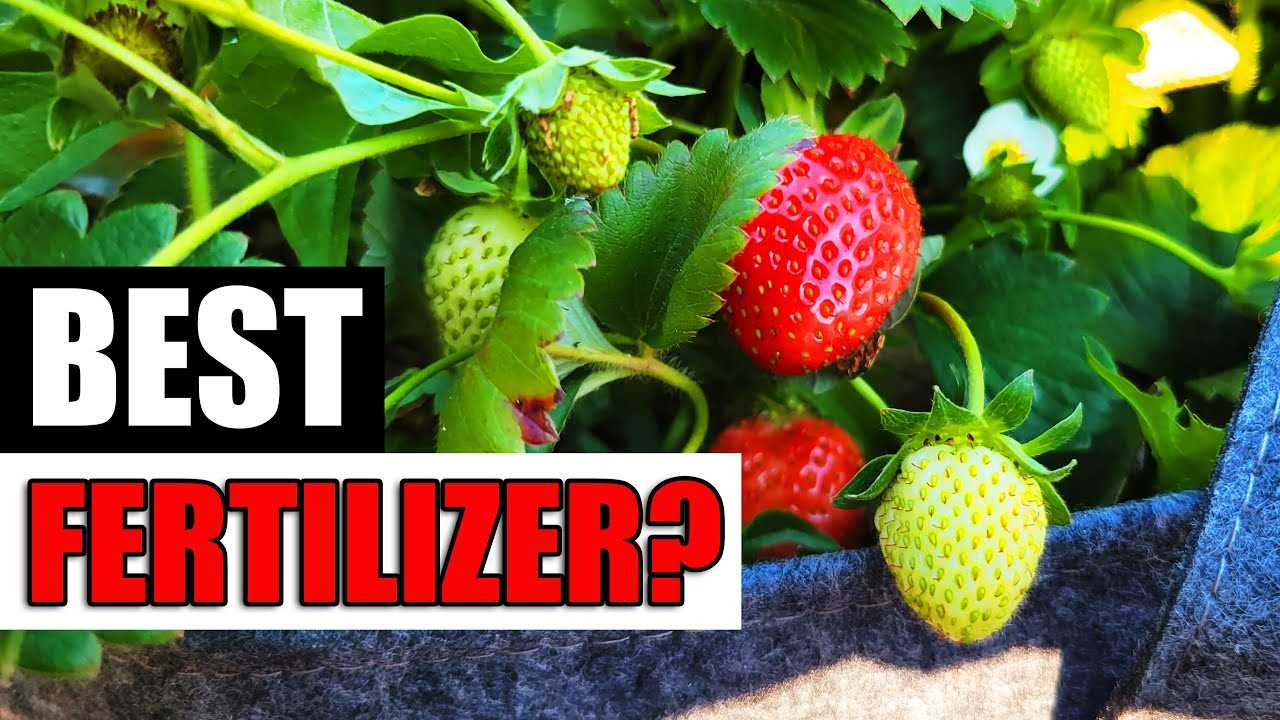
When it comes to fertilising strawberries, there are several options to choose from. Below are some common types of fertilisers that can be used to promote healthy growth and increased yields in strawberry plants:
- Organic Fertilisers: Organic fertilisers are derived from natural sources and are a popular choice for strawberry growers who want to avoid synthetic chemicals. They are typically made from composted plant material, manure, or other organic materials. Organic fertilisers provide a slow release of nutrients, which can help improve soil quality over time.
- Chemical Fertilisers: Chemical fertilisers are manufactured using synthetic components and are often used in commercial strawberry production. These fertilisers usually come in a granular or liquid form, and they provide a quick release of nutrients to the plants. Chemical fertilisers can be tailored to meet the specific nutrient needs of strawberries, but they should be used with caution and according to the instructions to avoid over-fertilisation.
- Slow-Release Fertilisers: Slow-release fertilisers are designed to slowly release nutrients over an extended period of time. They are often available in granular or pellet form and are ideal for strawberries because they provide a steady supply of nutrients to the plants. Slow-release fertilisers can be organic or synthetic, and they are a convenient option for those who prefer not to fertilise frequently.
- Foliar Fertilisers: Foliar fertilisers are applied directly to the leaves of the strawberry plants. They are typically in liquid form and can be sprayed onto the foliage using a sprayer. Foliar fertilisers are quickly absorbed by the leaves and can provide an immediate nutrient boost to the plants. They are often used during the growing season to address nutrient deficiencies or to supplement the regular fertilisation program.
In addition to choosing the right type of fertiliser, it is also important to consider the nutrient requirements of your strawberry plants. Conducting a soil test can help determine which nutrients are lacking in the soil and guide your fertiliser selection. Remember to always follow the recommended application rates and schedules provided by the manufacturer to ensure optimal plant health and productivity.
Table:
| Fertiliser Type | Advantages | Disadvantages |
|---|---|---|
| Organic Fertilisers | – Derived from natural sources – Slow release of nutrients – Improves soil quality | – May have variable nutrient content – Slower acting compared to chemical fertilisers |
| Chemical Fertilisers | – Quick release of nutrients – Customizable nutrient ratios | – Synthetic chemicals – Potential risk of over-fertilisation |
| Slow-Release Fertilisers | – Slow and steady nutrient release – Convenient application – Can be organic or synthetic | – May be more expensive |
| Foliar Fertilisers | – Quick nutrient absorption – Immediate nutrient boost – Can address deficiencies | – Regular application may be required – Can be easily washed off by rain |
The Best Soil Conditions for Strawberries
Strawberries are a delicate fruit that requires specific soil conditions in order to thrive. The right soil conditions can help to promote healthy growth, increased yield, and better overall quality. Here are some of the best soil conditions for strawberries:
1. Well-Drained Soil
Strawberries prefer soil that is well-drained to prevent waterlogging and root rot. Excess moisture can cause the roots to rot and can lead to the death of the plant. It is important to choose a soil type that drains well, such as sandy or loamy soil.
2. pH Level
The ideal pH level for strawberries is between 5.5 and 6.5. This slightly acidic pH range allows for optimal nutrient uptake by the plants. Testing the pH level of the soil and adjusting it if necessary can help to ensure that the strawberries have access to the nutrients they need.
3. Organic Matter
Incorporating organic matter into the soil can help to improve its structure and fertility. Organic matter such as compost or well-rotted manure can provide valuable nutrients to the strawberries and promote beneficial microbial activity in the soil.
4. Mulching
Mulching is a beneficial practice for strawberries as it helps to conserve moisture in the soil, suppress weeds, and regulate soil temperature. Organic mulches, such as straw or wood chips, can be applied around the plants to help maintain optimal soil conditions.
5. Fertile Soil
Strawberries require fertile soil that is rich in organic matter and nutrients. Applying a balanced fertilizer specifically formulated for strawberries can help to provide the necessary nutrients for optimal growth and fruit production.
6. Soil Structure
A well-structured soil with good drainage and adequate aeration is essential for strawberry plants. Soil compaction should be avoided, as it can hinder root development and reduce nutrient availability to the plants. Regular cultivation and addition of organic matter can help to improve soil structure.
| Fertilizer | Nitrogen (N) | Phosphorus (P) | Potassium (K) | Trace Elements |
|---|---|---|---|---|
| 10-10-10 | 10% | 10% | 10% | Various minerals |
| 14-14-14 | 14% | 14% | 14% | Various minerals |
| 18-18-18 | 18% | 18% | 18% | Various minerals |
By providing the best soil conditions for your strawberry plants, you can ensure that they will grow and produce high-quality fruit. Remember to regularly monitor the soil conditions and make any necessary adjustments to promote the health and productivity of your strawberry plants.
When and How to Apply Fertilisers to Strawberries
Fertilising strawberries is an important part of maintaining a healthy and productive strawberry patch. Knowing when and how to apply fertilisers can help ensure your strawberries receive the nutrients they need to thrive and produce an abundance of delicious fruit.
Timing of Fertiliser Application
The timing of fertiliser application for strawberries can vary depending on the specific needs of your plants and your local climate. However, there are some general guidelines to consider:
- Apply fertilisers in early spring: Start fertilising your strawberries in early spring, just as the plants are starting to actively grow. This will help provide a boost of nutrients as they begin their growing season.
- Repeat every 4-6 weeks: After the initial application, continue fertilising every 4-6 weeks throughout the growing season. This will help maintain a steady supply of nutrients for your strawberries.
- Avoid fertilising in late summer: As the strawberry plants enter their dormant period in late summer, it’s best to avoid fertilising them. Fertilising at this time can stimulate new growth that is more susceptible to cold weather damage.
Methods of Fertiliser Application
There are a few different methods you can use to apply fertilisers to your strawberry plants:
- Broadcasting: One common method is to broadcast the fertiliser over the entire strawberry patch. Use a spreader or your hand to evenly distribute the fertiliser. Be careful not to apply too much, as overfertilisation can harm the plants.
- Band application: Another option is to apply the fertiliser in a band along the row of strawberry plants. This can help target the nutrients directly to the plant’s root zone.
- Top-dressing: Top-dressing involves applying the fertiliser on the surface of the soil around the plants. This method is often used with slow-release fertilisers that gradually release nutrients over time.
Choosing the Right Fertiliser
When selecting a fertiliser for your strawberries, it’s important to choose one that is specifically formulated for fruit-bearing plants. Look for a balanced fertiliser with equal ratios of nitrogen, phosphorus, and potassium (NPK). Additionally, consider using organic fertilisers to promote long-term soil health and sustainability.
Conclusion
By properly timing and implementing the right methods of fertiliser application, you can ensure that your strawberries receive the nutrients they need for optimal growth and fruit production. Remember to follow the guidelines for your specific climate and adjust your fertiliser application accordingly. Happy gardening and enjoy your delicious strawberries!
Common Mistakes to Avoid When Fertilising Strawberries
- Over-fertilising: One common mistake when fertilising strawberries is applying too much fertilizer. This can lead to excessive nutrient levels in the soil, which can harm the plants and hinder their growth.
- Using the wrong type of fertilizer: It is important to use a fertilizer specifically formulated for strawberries. Using a general-purpose fertilizer may not provide the right balance of nutrients that strawberries require for optimal growth.
- Neglecting soil testing: Without knowing the nutrient levels in the soil, it can be difficult to determine the right amount and type of fertilizer to use. Soil testing is essential to identify any nutrient deficiencies or imbalances and to guide the proper application of fertilizers.
- Applying fertilizers at the wrong time: Timing is key when fertilising strawberries. Applying fertilizers too early or too late in the growing season may not provide the maximum benefit to the plants. It is important to follow the specific fertilisation schedule for strawberries to ensure they are getting the nutrients they need at the right time.
- Not following the recommended dosage: Overdosing or underdosing fertilizers can have negative effects on strawberry plants. It is important to carefully follow the recommended dosage provided by the fertilizer manufacturer to avoid any potential harm to the plants.
- Applying fertilizers to wet foliage: Fertilizers should not be applied to wet foliage as this can lead to leaf burn. It is best to apply fertilizers to dry foliage or to irrigate the plants before fertilising to ensure the fertilizer is effectively absorbed by the roots.
- Not properly incorporating fertilizers into the soil: Fertilizers should be properly mixed or incorporated into the soil to ensure even distribution of nutrients. Surface application may result in uneven nutrient availability and can lead to nutrient deficiencies or toxicities in certain areas.
- Using fertilizers past their expiration date: It is important to check the expiration date of fertilizers before using them. Using expired fertilizers may result in ineffective nutrient release or the introduction of harmful substances to the plants.
By avoiding these common mistakes, you can ensure that your strawberries are receiving the correct amount and balance of nutrients for healthy growth and maximum fruit production.
Organic vs. Chemical Fertilisers for Strawberries
Introduction
When it comes to fertilising strawberries, there are two main options: organic and chemical fertilisers. Each type has its own advantages and disadvantages, and it is important to understand the differences between them to make an informed decision for your strawberry plants.
Organic Fertilisers
Organic fertilisers are derived from natural sources, such as compost, manure, and organic matter. They are typically slow-release and provide a steady supply of nutrients over a longer period of time. Here are some key points to consider:
- Natural and Sustainable: Organic fertilisers are made from renewable resources and do not contain synthetic chemicals, making them a sustainable choice for strawberry cultivation.
- Improve Soil Quality: Organic fertilisers can improve soil structure, increase water-holding capacity, and promote beneficial microbial activity, leading to healthier plants.
- Reduce Chemical Runoff: Since organic fertilisers release nutrients slowly, they minimize the risk of nutrient leaching and reduce the potential environmental impact.
Chemical Fertilisers
Chemical fertilisers, also known as synthetic or inorganic fertilisers, are manufactured using synthetic compounds. They are generally fast-acting and provide an immediate supply of nutrients to the plants. Here are some important points to consider:
- Controlled Nutrient Composition: Chemical fertilisers are formulated with specific nutrient ratios, allowing for precise control over the nutrients provided to the plants.
- Quick Results: Chemical fertilisers can quickly improve plant growth, flowering, and fruiting, making them ideal for correcting nutrient deficiencies or promoting rapid growth.
- Potential Negative Impact: Overuse or improper application of chemical fertilisers can lead to nutrient imbalances, soil degradation, and environmental pollution.
Choosing the Right Fertiliser
The choice between organic and chemical fertilisers depends on various factors, including your gardening goals, soil quality, environmental concerns, and personal preferences. Consider the following when making your decision:
- Soil Testing: Conduct a soil test to determine nutrient deficiencies and pH levels, which can help you select the right fertiliser.
- Organic Certification: If you are growing strawberries for organic certification, you will need to use only organic fertilisers that meet the organic standards.
- Gardening Practices: Consider your gardening practices and long-term goals. Organic fertilisers may be a better fit if you prioritize soil health, sustainability, and long-term benefits, while chemical fertilisers may be more suitable for fast results and targeted nutrient supply.
Conclusion
Both organic and chemical fertilisers can be used successfully in strawberry cultivation, but it is crucial to weigh their pros and cons before making a decision. Choose a fertiliser that aligns with your gardening goals, environmental concerns, and the specific needs of your strawberry plants to ensure their healthy growth and productivity.
Troubleshooting Common Fertilisation Issues with Strawberries
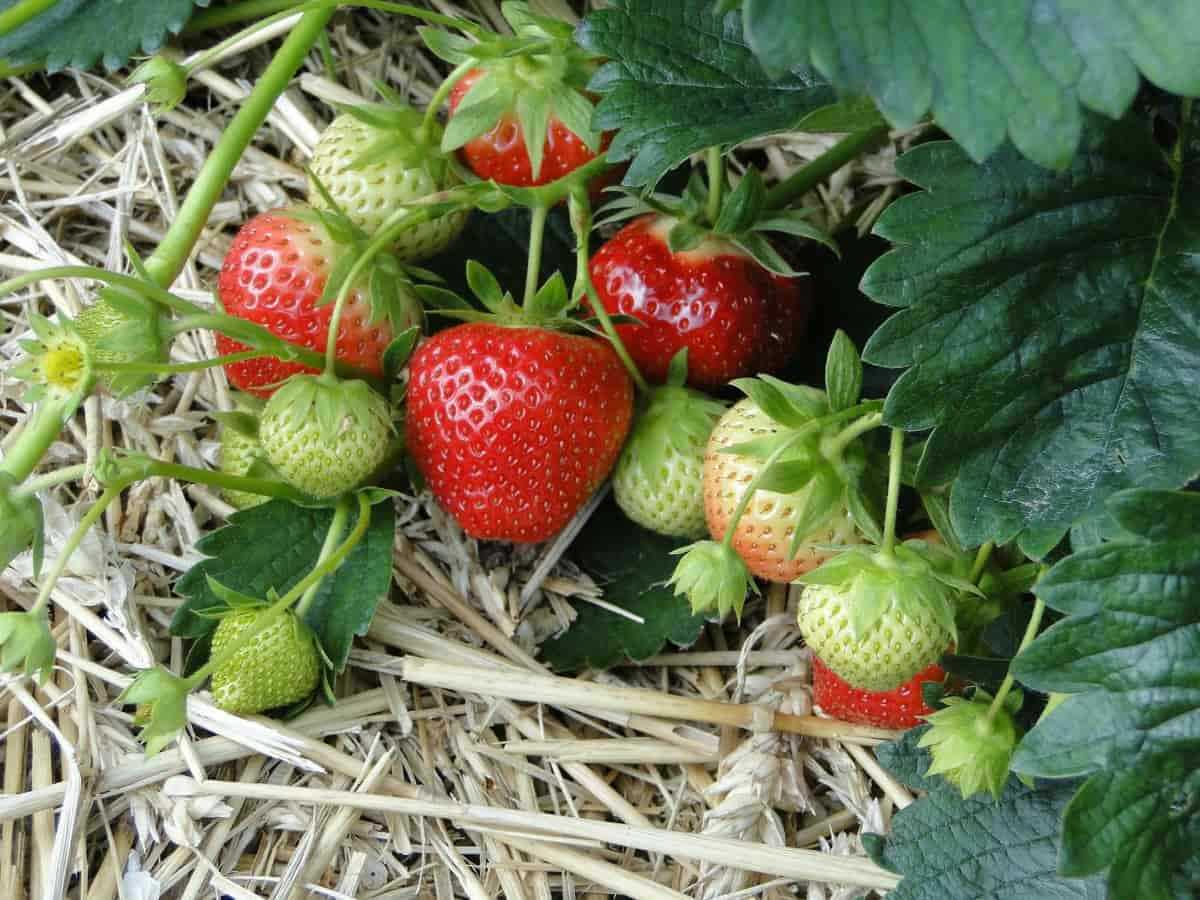
1. Over-fertilisation
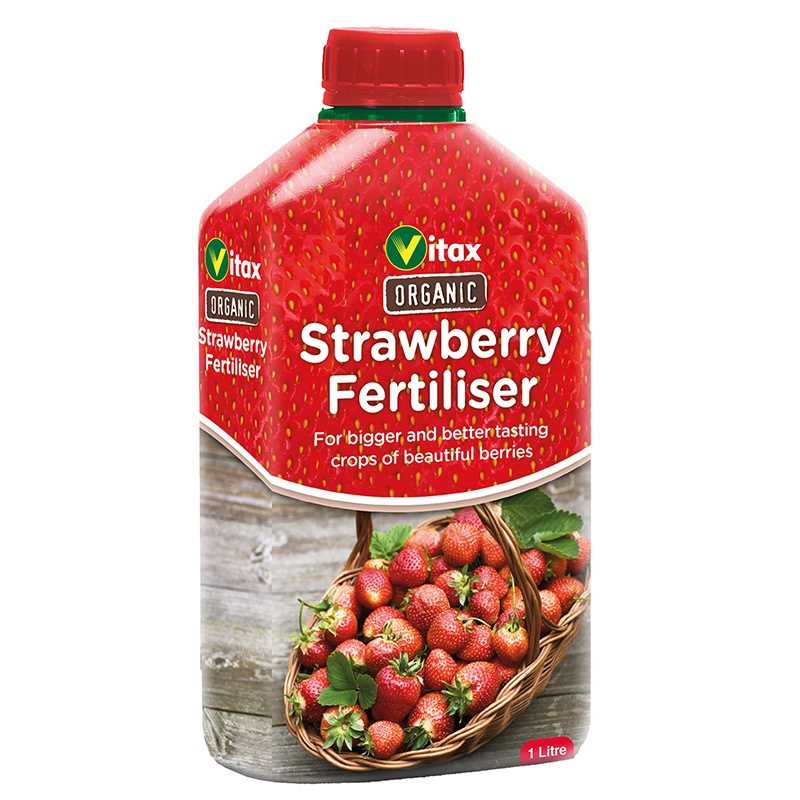
Over-fertilisation occurs when strawberries are given too much fertilizer, which can have negative effects on the plants. Symptoms of over-fertilisation include:
- Leaf burn or discoloration
- Stunted growth
- Reduced fruit production
To address over-fertilisation, it is important to avoid excessive use of fertilizers and follow the recommended application rates. Proper watering is also essential to flush out excess nutrients from the soil.
2. Under-fertilisation
Under-fertilisation happens when strawberries are not receiving enough nutrients from the soil. Signs of under-fertilisation include:
- Pale or yellow leaves
- Poor plant growth
- Small and fewer fruits
To combat under-fertilisation, it is necessary to provide the plants with the correct amount of fertilizer. Conduct a soil test to determine the nutrient levels and adjust the fertiliser application accordingly.
3. Imbalance of Nutrients
The improper balance of nutrients can cause various problems in strawberry plants. Common nutrient imbalances include:
- Nitrogen excess: Excessive nitrogen can lead to lush foliage growth at the expense of fruit production.
- Phosphorus deficiency: Insufficient phosphorus can hinder root development and result in poor fruit quality.
- Potassium imbalance: A lack of potassium can lead to weak plants and reduced resistance to diseases.
Regular soil testing and proper fertilisation practices can help maintain the correct nutrient balance for strawberries.
4. Inadequate Nutrient Availability
Even if the soil contains sufficient nutrients, they may not be readily available to the strawberry plants. Factors that can limit nutrient availability include:
- Inadequate soil pH: Strawberries prefer slightly acidic soil with a pH between 5.5 and 6.5. High or low pH levels can affect nutrient uptake.
- Soil compaction: Compacted soil can restrict root growth and nutrient absorption.
- Poor drainage: Excess water can cause nutrient leaching and deprive plants of essential minerals.
To improve nutrient availability, maintain proper soil pH, prevent compaction, and ensure adequate drainage in the strawberry bed.
5. Environmental Factors
Environmental factors can also influence fertilisation success with strawberries. Some common issues include:
- Temperature extremes: Extremely hot or cold temperatures can affect nutrient uptake and plant growth.
- Excessive rainfall: Heavy rains can wash away nutrients from the soil.
- Drought conditions: Lack of water can limit nutrient absorption by the plants.
Monitor the weather conditions and take appropriate measures, such as providing shade or shelter, adjusting irrigation, or using mulch, to mitigate the impact of environmental factors on fertilisation.
Tips for Maximising Strawberry Growth and Yield with Fertilisers
Proper fertilisation is crucial for achieving optimal growth and high yields in strawberry plants. Here are some tips to help you maximise strawberry growth and yield with the right fertilisers:
1. Soil Testing
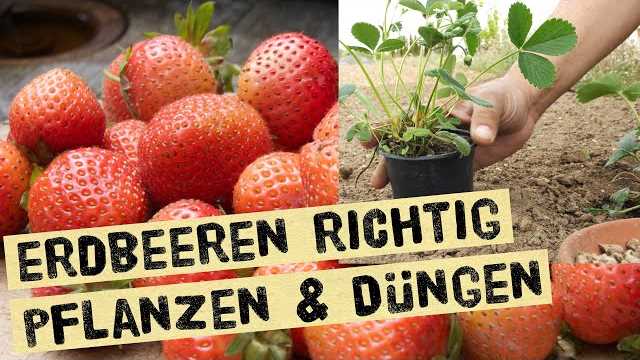
Before applying any fertilisers, it is important to conduct a soil test to determine the nutrient levels and pH of your soil. This will help you identify any deficiencies or imbalances that need to be addressed.
2. Balanced Fertiliser
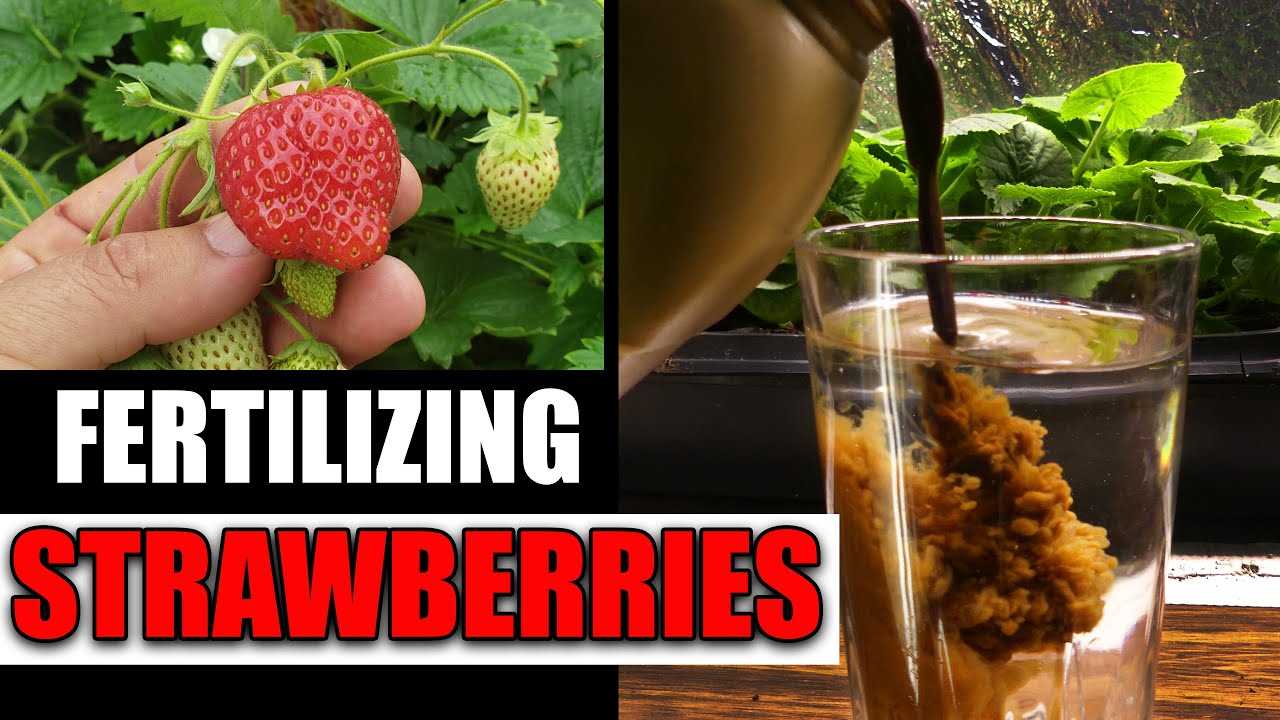
Choose a balanced fertiliser that provides a mix of essential nutrients, including nitrogen, phosphorus, and potassium (NPK). Strawberries require different nutrient ratios at different growth stages, so it is important to follow the recommended application rates and timings.
3. Organic Fertilisers
Consider using organic fertilisers, such as compost or well-rotted manure, which provide slow-release nutrients to the plants. Organic fertilisers also improve soil structure and promote beneficial microorganisms, leading to healthier plants.
4. Controlled-Release Fertilisers
Another option is to use controlled-release fertilisers, which release nutrients slowly over time, providing a steady supply to the plants. This can help reduce the risk of nutrient leaching and minimise the need for frequent application.
5. Foliar Feeding
In addition to soil application, foliar feeding can be an effective way to deliver nutrients directly to the leaves. Foliar sprays can be applied during key growth stages or when nutrient deficiencies are evident.
6. Timing and Frequency
Timing and frequency of fertiliser application are crucial. Apply fertilisers before planting to prepare the soil, and then continue with balanced applications throughout the growing season. Adjust the frequency and amount based on plant needs and weather conditions.
7. Watering Practices
Proper watering is essential for nutrient uptake. Overwatering or underwatering can affect nutrient availability and uptake by the plants. Maintain a consistent and appropriate level of soil moisture to ensure optimal nutrient absorption.
8. Mulching
Mulching helps conserve soil moisture, suppress weed growth, and regulate soil temperature. Additionally, organic mulches can gradually decompose, releasing nutrients into the soil and providing a natural fertiliser for the strawberries.
9. Avoid Excessive Fertilisation
While it is important to provide adequate nutrients, overfertilisation can be detrimental to strawberry plants. Excessive fertilisation can lead to nutrient imbalances, salt build-up, and environmental pollution. Follow the recommended application rates and avoid applying fertilisers during periods of stress.
10. Monitor Plant Health
Regularly monitor the overall health of your strawberry plants. Look for signs of nutrient deficiencies or excesses, such as yellowing leaves or stunted growth. Adjust your fertilisation practices accordingly to address any issues promptly.
Conclusion
By following these tips and practices, you can maximise strawberry growth and yield with the right fertilisers. Remember to analyse your soil, choose the appropriate fertilisers, and apply them at the right time and frequency. Regular monitoring and proper watering practices will further ensure the health and productivity of your strawberry plants.
Question-answer:
What nutrients do strawberries need for proper fertilisation?
Strawberries need a variety of nutrients for proper fertilisation, including nitrogen, phosphorus, and potassium. They also require micronutrients like iron, manganese, and zinc.
How often should strawberries be fertilised?
Strawberries should be fertilised every 4-6 weeks during the growing season. However, it’s important to follow the instructions on the specific fertiliser being used, as different products may have different application rates.
Can organic fertilisers be used for strawberries?
Yes, organic fertilisers can be used for strawberries. Organic options like compost, manure, and fish emulsion provide nutrients to the plants while improving soil health and fertility.
Is it necessary to fertilise strawberries if they are grown in nutrient-rich soil?
Even if strawberries are grown in nutrient-rich soil, it is still beneficial to fertilise them. Regular fertilisation ensures that the plants receive a consistent supply of nutrients, promoting healthy growth and higher yields.
What are the signs of nutrient deficiency in strawberry plants?
Signs of nutrient deficiency in strawberry plants can include yellowing or discoloured leaves, stunted growth, and reduced fruit production. It’s important to identify the specific nutrient deficiency and adjust the fertilisation accordingly.
Can over-fertilisation harm strawberry plants?
Yes, over-fertilisation can harm strawberry plants. Excessive amounts of fertiliser can lead to “burning” of the roots, which can stunt growth and even kill the plants. It’s important to follow the recommended application rates and not exceed them.
Are there any natural alternatives to chemical fertilisers for strawberries?
Yes, there are natural alternatives to chemical fertilisers for strawberries. Some options include using compost, seaweed extract, or bone meal. These natural fertilisers provide nutrients to the plants without the use of synthetic chemicals.







